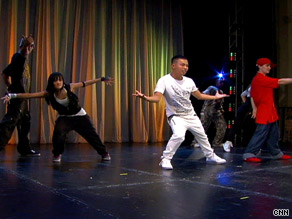Washington (CNN) – Six hip-hop artists from five countries speaking four languages are on stage, warming up to the show at Kennedy Center for the Performing Arts.

International hip-hop artists will warm up for a show at Kennedy Center for the Performing Arts on Tuesday.
I don’t really take “warming up.” The dancers explode across the stage, each in a different hip-hop style.
Michelle Salazar is chic cracked in black jeans and a white T-shirt, with her long black hair swirling around her head. Hassan El Huff, from Lebanon, is tall and thin, a kind of electric hip hop mixed with salsa.
Argentina’s Mauricio Trek and Sylvia Fernandez move on to a dramatic breakdance. Both are from Argentina, a tango home. Hien Ngoc Pham, originally from Vietnam, is buzz cut, wearing white jeans and a white T-shirt, brings Broadway bravery to his every move.
The dance stops and Summer Summerne begins rapping in Arabic. No translation is required. It comes from his soul.
Three weeks ago, the dancers never met, but are now a team participating in the Department of State’s Cultural Visitors Program. The program consists of three weeks of meeting American hip-hop artists and dancers and visiting New York City, Philadelphia and Washington, DC.
“It’s like a dream come true for me,” Salazar said Tuesday on the team’s show day.
Salazar isn’t just attacked by a star. She has learned a lot and she plans to bring it back to her fellow Phillipine dancers.
“There’s not much foundation for the Philippines dancers. [in hip-hop]”She doesn’t understand why the dancers do this” – she moves her arms – or why they do this” – she poses. I can feel it by looking at these [American] Hip hop dancer. ”
Summerne agrees: “You have to feel it.” His wrapping comes from the inside out, he says. “Even if you don’t know the language, you can still be involved in what I’m saying.”
When Samane rapped in his hometown of Nablus on the West Bank, he says he “seeks God to bring peace to our land.”
Columbia Barros, the vibrant director of the State Department’s Cultural Programs Department, says that cross-blowing of culture is the program’s goal.
“There’s nothing to replace being in the US, meeting Americans, seeing America’s wealth and diversity, and that’s irreplaceable,” she says.
The Cultural Visitor Program is part of the State Department’s cultural programming around the world. The $8.5 million budget is supplemented by agencies like the Kennedy Center, which co-hosts the performance.
Most of the visiting artists in the program have found ways to head towards professional dance through hip hop.
A member of the Vietnam Dance Association, Pham is currently working to open a hip-hop training centre in Ho Chi Minh City to reach out to young people.
He says with a broad smile, “Hip hop is that kind of energy. It’s so young. It’s also an opportunity for our country to approach, and I have many friends all over the world.”

Hip hop may have started in the US, but it belongs to everyone. Here’s how Hassan El Huff puts it: When he arrived in New York, he felt as if he had landed on his “real planet.”
“Yeah, I see them, all the dancers on the street, all the people who like music, hip hop music,” he says. “When I play hip hop, it always makes me feel happy. This is my life.”
About everything US Department of State • Hip-hop and rap • Hip-hop culture


